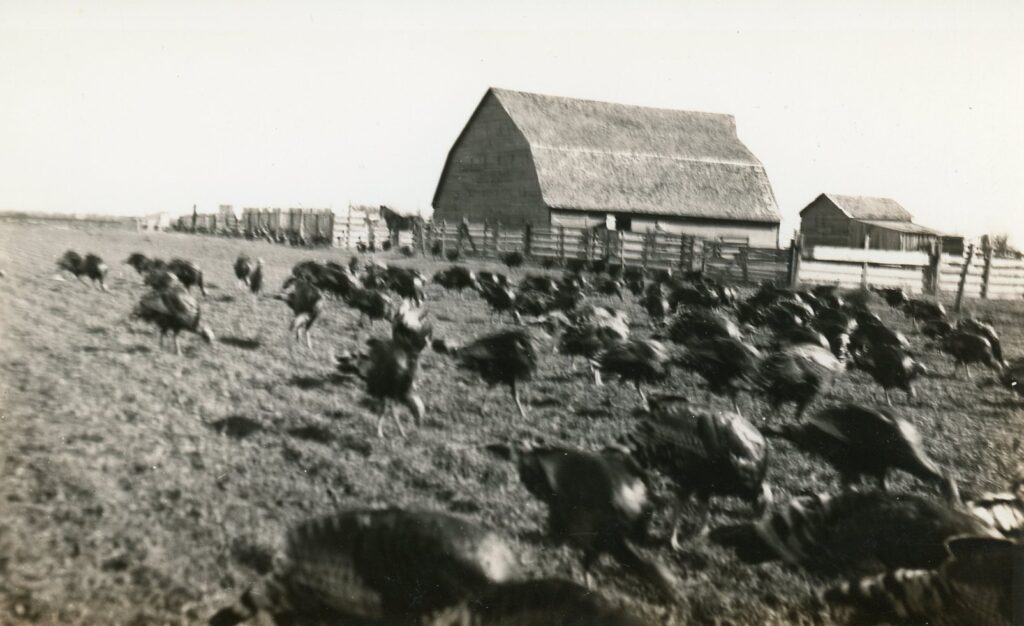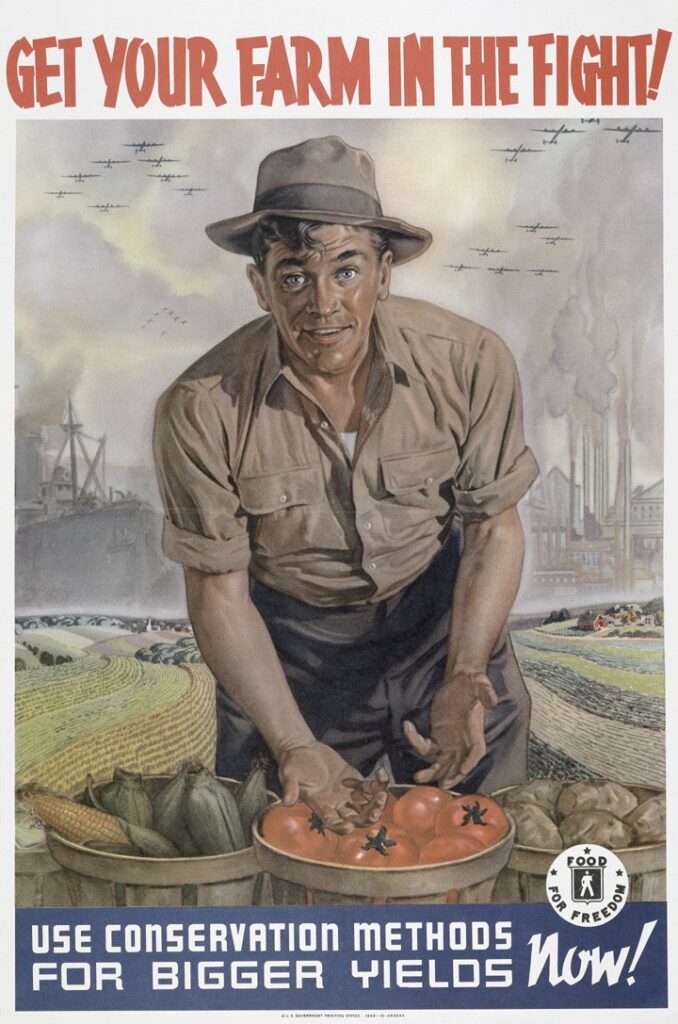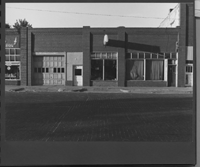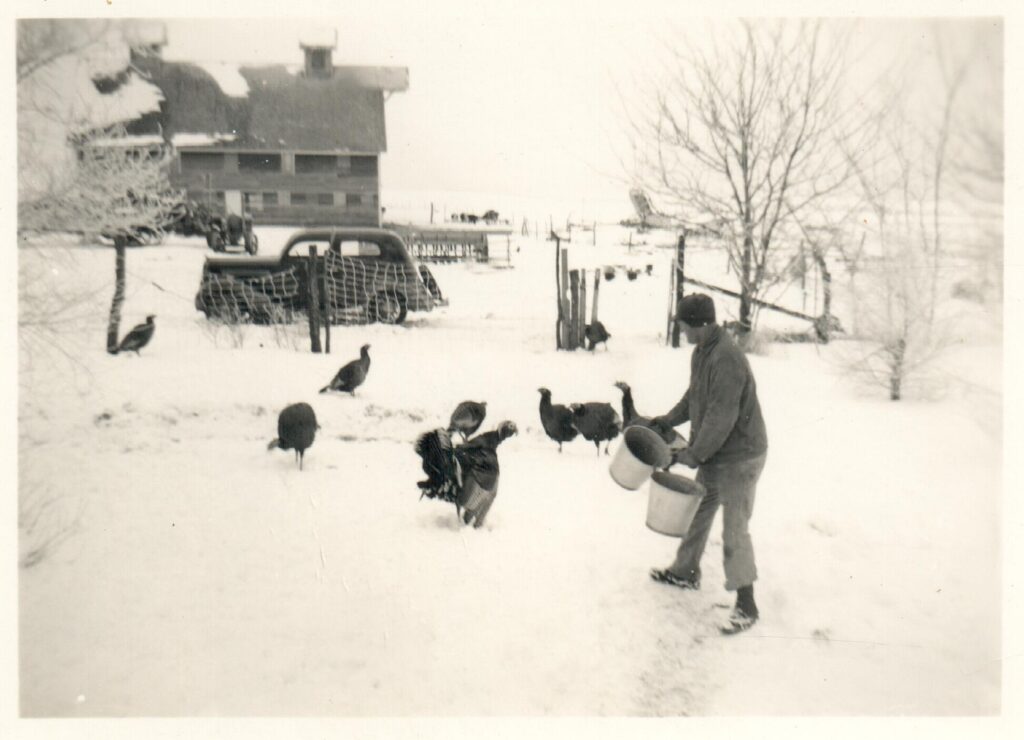Turkey was only one of the meats at the first Thanksgiving celebration held 400 years ago this year. However, it was not the mainstay until after President Lincoln made Thanksgiving a national holiday in 1868 that this American bird became the tradition.
I found the earliest mention of “turkeys” in Edwards County in the January 4, 1889 issue of the Kinsley Graphic. The article related how “On Saturday evening, before Christmas, George Clement was on his way home (south of Lewis) with a large (live) turkey that he had won at a shooting match.”
When George was passing Squire Polings’ house, he heard music, and decided to stop in. He did not think it would be polite to take his turkey into the house, so he found a large wooden box and turned in upside down over the bird. An hour later, when he came out, he discovered that a stray dog had found his turkey, dug under the box, and eaten about half. “The other half was still alive, (turkeys are very tenacious of life), and the Squire was called upon to act as chief decapitator and put an end to its suffering.”
The turkey shooting match mentioned above had been a popular event since early 1800 when it did involve live birds. But by this time, participants did not actually shoot turkeys. They received frozen turkeys as prizes for their luck at landing one BB shot in a small circle on a target. Turkey shoots are still held today.
Another turkey shoot mentioned was held at U. G. Leslie’s in Wendell in 1894 where a lucky Dave Heath won 4 turkeys before he was barred from further competition. In 1914, Everett Nichols provided 45 turkeys and 10 geese for prizes at his shoot. The L. J. Runsey farm advertised that 70 turkeys would be given away at their shoot in 1916.
By the early 1900s, area farmers were raising turkeys for market. The turkeys were “…brought to the produce house, where one man does all the killing. He has specialized in that and can stick them so that they will be easily picked…. The ‘picking corps’ consists of a number of men, who, after a little practice, can literally ‘make the feathers fly’. With a very few minutes work, they can make a turkey look ‘as if it had been born that way’. After picking, the turkeys are taken to the ice house where they are cooled to about thirty-five degrees before they are packed in wooden barrels and shipped to eastern points.” (Kinsley Mercury, November 16, 1922)
On November 30, 1922, the editor of the Graphic reported the importance of the turkey market to the local economy. “Last week we called attention to the fact that the Lee Produce company (located opposite Kinsley High School) had shipped three carloads of dressed turkeys from this station in one week …. The poultry raisers who made these shipments were possibly paid more than $20,000 in cash; that much money was put in circulation here in one week just by this one firm. Another thought. It would take about twenty loaded wheat cars to represent the same amount of money, more carloads of wheat than have been shipped from this station in the past three months. If you take into consideration the money paid out by this firm for other poultry and eggs, also add the amounts put in circulation by other buyers, the sum paid out for poultry and eggs reaches an astonish total, more than equals the wheat crop of Kansas. Yet we rarely see a word in print regarding the great movement of poultry and eggs, while the clamor regarding wheat is heard all over the country.”

Turkeys proved to be a good crop during the Dust Bowl, Depression and WWII. Clair Bidleman was winning prizes with his turkeys in national shows in the early 1930s. In 1936, Glen Bidleman started a turkey marketing pool called the Southwest Kansas Market association. Turkey raisers in Edwards, Ford, Hodgeman, Kiowa, Rush, Stafford, and Pawnee counties banded together to process their turkeys here. They combined with a larger cooperative in Hutchinson which paid 50% of the NYC market price. A second payment, adjusted for the fluctuating market, was made at the end of the season.
This co-op rented a building north of the Schnatterly Grocery store (422 Colony, currently Brown Auction) for $1 a day, and rented refrigeration space at the nearby Home Ice Company for 2 cents/100 lbs.
The Kinsley Mercury described the operation. “The noise made by pickers pulling the feathers from the scalded turkeys goes on throughout the day until all birds for the day’s kill have been ‘pinned’…. Rubber boots and rubber aprons are used in the workshop since the wet turkeys keep the floor and those who work in the building, damp.” (Nov. 12, 1936)
That year, county agent George Sidwell reported that four car loads of approximately 7,800 turkeys shipped from Kinsley in November, and he expected the same would be shipped in December.

Raising turkeys during World War II not only offered a financial incentive, but also a patriotic one in support of the “Food for Freedom” campaign. In 1941, the co-op, or turkey pool as it was sometimes called, became the Arkansas Valley Turkey Co-op and it had 430 members.

The co-op bought the building at 319 E. Sixth St. and installed a new scalding machine and automatic picker. Charles Schmitt described the picker as having “little rubber fingers on it – little knobs on it. We’d just hold the turkey up, and it would pull the feathers right off. Maybe the wings or the tail you had to pull out, but they looked pretty nice when we boxed them up and loaded them in the freight car.”
“Once in a while,” he continued, “when the steam engines came in, they’d bump the car and it would knock (the boxes) over, and we was asked to go back out for time-and-a-half (pay) and a case of beer! Us boys would just throw them clear back up there. We made a lot of fun out of it.”
Glen Bidleman reported in a magazine article that in 1941 they sold more than 400,000 pounds of dressed turkeys and expected to double that in 1942. Many people, including teenagers, worked for two weeks in November and again in December.

Fred Strate was the Secretary/Treasurer of the turkey co-op. In 1943, he and his wife Gladys earned more than $1300 for the turkeys that their children Delphi, Lionel, Roma and Kay raised.
I’m not sure when the turkey cooperative ended, but they did sell the building in April, 1952. Perhaps the fall of 1951 was the last year, but If anyone can pin point their last season, the library would like to know so can be added to the archive.
The Kinsley Library Board and staff wish everyone a perfectly roasted turkey and a Happy Thanksgiving.
